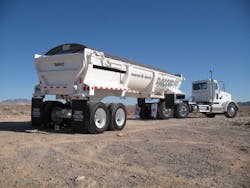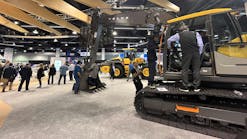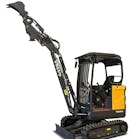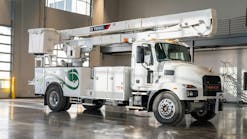The primary focus is on carbon dioxide, now three times more abundant in the atmosphere compared to pre-industrial times and believed to contribute to Global Warming—now less contentiously called Climate Change. Extra cost for new equipment and technologies will be paid back through less money spent on fuel, the agencies contend. Although the feds are infamous for underestimating costs to users, publication of the rules has met mostly praise from truck builders and cautious backing from trucking organizations.
The onus on meeting Phase 2 is on vehicle manufacturers, not users, says Ben Sharpe, a principal researcher at the International Council on Clean Transportation (ICCT), whose staffers have been studying the 1,690-page document. That means manufacturers will have to determine how the rules affect each of their vehicle types, then design and build them and certify that they meet the regs. This is how engines are now designed, produced, and sold, and will continue to be. The regs have provisions for engines produced separately and as part of a truck series. That means Cummins, the last independent manufacturer of truck engines, can continue to be a player, while companies that build engines as well as vehicles—which is most medium and heavy truck builders—can continue their efforts in vertical integration. Phase 2 also greatly limits production and use of glider kits, whose use will be curtailed over the next four years.
Phase 2, which picks up where the current (and easily met) Phase 1 rules leave off, affects road tractors and vocational trucks, and the engines used in them. It also regulates commercial pickups and vans, and, for the first time, trailers. Fuel will be saved through advances in engine design, and by cutting wind drag from vehicles and friction produced by tires. Phase 2 further classifies truck types by use: “regional,” “urban,” and “multipurpose.” Sharpe says it appears that highway trucks will be considered regional; dump trucks will be under the urban designation; and concrete mixer chassis will be among multipurpose vehicles that might also include block, equipment service trucks, crane carrier chassis, and other construction vehicles.
Compared to 2010-model diesels, the two phases together mean as much as a 27-percent reduction in fuel consumption by 2027. This is why builders have been introducing smaller, more efficient engines in all truck types and lighter bodies and other components. The rules will have serious effects on highway freight haulers because they are numerous and often travel long distances at high speeds. But vocational trucks average relatively low speeds on shorter trips. They often have bodies that see rough or specialized service that precludes being built with aerodynamic characteristics. So regulators are not demanding huge improvements for such vehicles.
For the first time here and in the world, ICCT’s Sharpe notes, American authorities will regulate trailers as a means to gain fuel economy and reduce exhaust emissions. Phase 2 focuses principally on “box”-type vans and reefers that haul freight and perishable commodities like foods, paint, and cosmetics. Trailers and the tractors pulling them will have to be dealt with as single units, where aerodynamic lines on tractors continue into the trailers’ exteriors. Many of these box trailers already have aero improvers like side skirts and folding boat tails to reduce wind drag. Use has been voluntary, either because owners have proved that they can save money with the equipment, or they run in or into California, where state authorities have mandated use of side skirts and low-rolling-resistance tires—another method to cut drag—on long box trailers.
However, vocational trailers like flatbeds and dumpers will not face aerodynamic requirements. They’ll have to use low-rolling-resistance tires and tire-management devices to save fuel. Easy-rolling tires now are employed mainly on vans and reefers that stay on pavement. Dumpers and other vocational trailers often hop curbs and move onto rough terrain, so Phase 2 is likely to spur development of on/off-road tires that roll easily but also stand up to punishing conditions.
Devices that monitor tire inflation pressures and pump them up when necessary are readily available, and moderate in cost. Operators who use them find they not only save fuel, but also extend tread life, preserve casings for retreading, and reduce instances of flats and other failures that lead to expensive road-service calls. The devices do have to be looked after, but fleet managers have said that benefits outweigh any maintenance expense.
How diesels will improve
2017 is the first year for economy and emissions-reduction improvements required under current federal regulations, so all builders of truck engines will come out with refined and sometimes new engines to meet the rules. At this writing, Cummins and Volvo-Mack have formally announced what their 2017-model diesels will include; others have scheduled announcements just after our deadline or early in October. It’s expected that all builders’ mechanical improvements will, like those now public, include advances in combustion efficiency, fuel systems, air handling, and exhaust aftertreatment equipment. As always, they’ll also tweak electronic controls for greater efficiency and performance.
Cummins
“A new engine and new name bring a new era to Cummins,” said Jim Fierz, an engineering vice president, at a press introduction of the latest 14.9-liter product in late summer. Current engines already meet standards for fuel economy and greenhouse gases, so Cummins has reengineered and renamed its 2017-model diesels with an emphasis on fuel economy and uptime. The new engines are more fuel efficient, reliable, long-lasting, and drivable than anything that has come before in its lineup. The new big-bore diesel has undergone 9 million miles of testing with fleets and Cummins’ own trucks, with the highest single-truck mileage exceeding 500,000.
The big-bore ISX15 becomes the X15 as of January, when it goes into production. Cummins has dropped “IS” from the names of all medium-, medium-heavy, and heavy-duty on-highway products, also resulting in the designations B6.7, L9, and X12 as well as the X15. Midrange engines were unveiled last spring, and the X15 was the main focus of the press event at Ohio’s Transportation Research Center in August. The X15’s mechanical advances over the current model include:
• An optimized cam profile to minimize inherent parasitic loss and easier breathing during combustion;
• A very high compression ratio and better thermal efficiency, enabled by the Cummins variable-geometry turbocharger and XPI fuel system, to improve engine response and reduce fuel consumption;
• Minimal friction losses throughout the engine, including the water pump, gear train, lube system, pistons, and exhaust gas recirculation parts;
• A series of durability-focused upgrades, including camshaft lobes, piston cooling nozzles, and the air-handling system; and
• Reduced maintenance, including oil-drain intervals from extended to as much as 50,000 miles when used with a new Cummins oil analysis program.
The X15 will come in two series: Performance, with ratings from 485 to 605 horsepower and 1,650 to 2,050 lb.-ft. of torque; and Economy, with 400 to 500 horsepower and 1,450 to 1,850 lb.-ft. Engine brakes will make up to 600 retarding horsepower, and retarding will continue into low-rpm ranges. Efficiency and Performance engines can be up- and down-rated within their series by reprogramming their electronic controls. However, hardware differences—piston designs, for instance—preclude practical turning of an Efficiency engine into a Performance type or vice versa.
The medium-bore (as Cummins calls it) X12 will enter the American and Canadian market in 2018. The X12 is practically an all-new engine and weighs 130 pounds less than the nearest competitor. Its claimed weight of 2,050 pounds, compared to 2,650 for the current ISX12, is achieved with a sculptured block design that removes unnecessary mass but retains high rigidity. High-strength composite materials for the oil pan and valve cover cut more poundage.
Low mass should make the X12 attractive to weight-sensitive applications, such as heavy concrete mixer trucks that need more power than is available from the 8.9-liter ISL9 (soon-to-be L9) that’s been popular in mixers. Dump truck operators, too, tend to use 11- to 13-liter diesels, so should welcome the new X12 when it becomes available. It’s already in production, said a test engineer during a driving demonstration, and is being delayed for introduction here because resources are now being devoted to putting the X12 into Central and South America and other foreign markets where smaller engines are more commonly used.
Cummins engines have begun using Connected Diagnostics, an advanced telemetry system that lets owners monitor performance and determine faults while trucks are at work. It also allows over-the-air recalibrations of electronic control modules without having to take trucks to dealers. Drivers are notified by a signal on the information centers, and can park and tell the ECU to “take” the update, or refuse it and wait until it’s more convenient. Tuning of operating parameters by managers is done through a Web portal, a feature now installed at the factory and available for use to any owner.
A single-module aftertreatment system with in-line components replaces the multi-turn system now used. The oxygen catalyst, diesel particulate filter, and exhaust fluid injector and dosing chamber are close together so high temperatures needed for efficient operation are maintained, said Jim Nebergall, part of the engineering team that developed it.
“The single aftertreatment module is simpler, and exhaust flow is consistent no matter what the application,” he said. “So sensor readings are more reliable. We actually removed a temperature sensor because there’s less variation throughout the system.” End caps can be side-entry and -exit or straight-through, or a combination of the two, to accommodate customer wishes and packaging demands. Side-entry/exit caps can be “clocked” or turned to line up with inlet and tail pipes to best suit an installation.
Volvo and Mack
Volvo Trucks announced details of its 2017-model engines last March and again in July, and Mack Trucks did so in April and September. Although officials at the sister companies act independently and seldom speak of each other, in fact they are commonly owned by Volvo Group and share engines, automated transmissions, and some axles produced by the group’s power train plant in Hagerstown, Md. Each company spends considerable resources developing separate programming for electronic controls to achieve unique operating characteristics. And some horsepower and torque ratings differ slightly. But mechanically, the engines differ only in designations and paint color: D series and green for Volvo and MP series and dark red for Mack.
Both builders’ 2017 diesels will include more efficient fuel and combustion systems and, in a D13 and MP 8 model, use turbo compounding to add power, responsiveness, and fuel economy, officials said at their respective announcements. The products will be phased into production at the plant starting this fall and into next year. The 15.9-liter D16/MP 10 was previously improved, so the major changes will go into 10.8-liter D11/MP7 and 12.8-liter D13/MP 8 diesels.
Among mechanical changes are a new “wave” piston design that increases the compression ratio to 17:1 (from 16:1) for improved fuel efficiency. Flame propagation is enhanced with six ridges that separate the crown into six areas in which to begin fuel burn. The injector, located in the center of the piston top, has six orifices to spray fuel into those areas; compression heat ignites the fuel and sends flames toward the center of the crown, where burn is finished. Complete combustion reduces soot by 50 percent and contributes to economy gains. Pistons are treated to reduce friction between them and cylinder walls. A common-rail fuel system is packaged under the new split valve cover for protection and easier servicing.
Turbo compounded D13-TC and MP 8-TC will not be vocational models, but could be employed in hauling building supplies and in carrying cement, aggregates, and liquid asphalt to batch plants, so the TC upgrade is worth describing: It will have a second turbocharger linked via fluid coupling and a geartrain to the crankshaft, grabbing otherwise wasted energy from the exhaust to gain as much as 50 horsepower and 4 percent in fuel economy. As that power develops, fuel to the engine will be cut back slightly so the TC function does not produce extra performance but extra economy, the Volvo and Mack officials explained. The TC is designed for long-hauling at steady highway speeds, mostly 65 mph, and will be offered on sleeper-cab VN and Pinnacle when it becomes available in mid-2017.
The D11/MP 7 will get a top rating of 425 horsepower, up from the current 405. The D13 will go to 500 horsepower and the MP 8 to 505, and Volvo’s popular 455-horsepower rating will add 100 lb.-ft., going to 1,850 lb.-ft. The D11 will deliver 2.2 percent better fuel economy than the current model, while the D13 gains 2.5 percent. Adding turbo compounding’s 4 percent gain means the D13 TC will be as much as 6.5 percent better in highway service (Mack says 8 percent). When spec’d with Volvo’s XE (for eXceptional Efficiency) and Mack’s Super Econodyne “downspeeding” packages and a 2.47 rear axle or 2.55 ratio, a TC will cruise at 1,050 to 1,100 rpm in top gear at 65 mph. The special packages include automated mechanical transmissions (which now go into more than 80 percent of Volvo’s and Mack’s highway trucks and 20 to 25 percent of vocational models as of May). The new D11/MP 7 goes into production in January, the improved D13/MP 8 will enter production in October, and the TC engines enter production next summer.
A new compact aftertreatment system, called One Box by Volvo and ClearTech One by Mack, weighs 17 pounds less and is 12 inches shorter than the current “teapot” system. So it takes less frame space, which in vocational trucks allows a foot more room to mount a body, a lift axle, or other equipment. In highway trucks, it can allow wheelbase shortening for better maneuverability and weight reduction because the frame is shorter. Components are close together to maintain proper operating heat, which should reduce the need for fuel-burning active regenerations to burn out soot. The diesel particulate filter’s substrate can be quickly removed for cleaning out ash or entire replacement.






